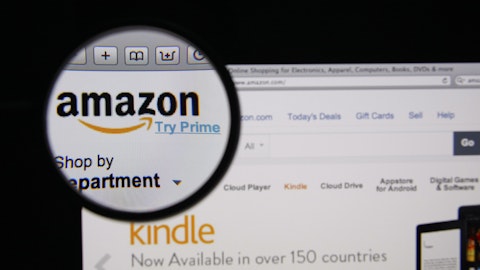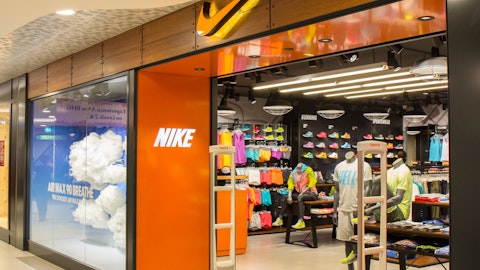In this article, we discuss the 5 famous value stocks that underperformed in 2022. If you want to read about some more value stocks, go directly to 10 Famous Value Stocks that Underperformed in 2022.
5. Lowe’s Companies, Inc. (NYSE:LOW)
Number of Hedge Fund Holders: 65
PE Ratio: 16.83
Percentage Decline in Share Price YTD as of August 12: 19.19%
Lowe’s Companies, Inc. (NYSE:LOW) is a home improvement retailer. In late July, the firm announced that it planned to use the metaverse technology to allow users to see the upgrades they had opted for in virtual reality before implementing it at their homes. As part of this plan, the firm will make more than 500 3D product assets available for download for free via the Open Builder platform. The home improvement retailer is expected to issue an earnings report in mid-August as retailers struggle with bloated inventories.
On August 11, Citi analyst Steven Zaccone downgraded Lowe’s Companies, Inc. (NYSE:LOW) stock to Neutral from Buy and lowered the price target to $205 from $222, noting the weakening macro backdrop as one of the main reasons behind the downgrade.
At the end of the first quarter of 2022, 65 hedge funds in the database of Insider Monkey held stakes worth $5.5 billion in Lowe’s Companies, Inc. (NYSE:LOW), compared to 72 in the preceding quarter worth $6.8 billion.
In its Q4 2021 investor letter, Pershing Square Capital Management, an asset management firm, highlighted a few stocks and Lowe’s Companies, Inc. (NYSE:LOW) was one of them. Here is what the fund said:
“Lowe’s Companies, Inc. (NYSE:LOW) is a high-quality business with significant long-term earnings growth potential
Supportive macroeconomic backdrop
-Aging housing stock, lack of new inventory, robust home equity values, and unprecedented pro project backlog
-COVID-19 causing millennials to enter the housing market
Positioned to grow EPS largely independent of market conditions
-Idiosyncratic revenue opportunities driving share gains
-Self-help initiatives catalyzing operating margin expansion
-Buybacks representing ~8% of current market capitalization planned for 2022
Multi-year business transformation with substantial earnings upside
-Margin target of 13% has substantial upside; Home Depot at ~15.3% and increasing
-Potential to generate high-teens EPS growth over the next several years.
Lowe’s Companies, Inc. (NYSE:LOW) continues to trade at a significantly discounted P/E multiple relative to Home Depot despite materially higher prospective EPS growth. LOW’s share price including dividends increased 63% in 2021 and has decreased 10% year-to-date in 2022.”
4. Cisco Systems, Inc. (NASDAQ:CSCO)
Number of Hedge Fund Holders: 66
PE Ratio: 16.35
Percentage Decline in Share Price YTD as of August 12: 26.20%
Cisco Systems, Inc. (NASDAQ:CSCO) makes and sells networking and other products. In late June, the company announced that it planned to fully wind up operations in Russia and Belarus amid the Russian invasion of Ukraine. In March, the company had suspended sales and services in Russia. The move comes as the US sanctions firms working in Russia that provide Moscow with access to critical technology and equipment that can be used as part of cyber attacks in the US or on US allies.
On July 14, JPMorgan analyst Samik Chatterjee downgraded Cisco Systems, Inc. (NASDAQ:CSCO) stock to Neutral from Overweight with a price target of $51, noting that there were increasing signs of the challenging macro feed into demand trends.
At the end of the first quarter of 2022, 66 hedge funds in the database of Insider Monkey held stakes worth $1.7 billion in Cisco Systems, Inc. (NASDAQ:CSCO), compared to 57 in the previous quarter worth $3.4 billion.
Here is what Hayden Capital has to say about Cisco Systems, Inc. (NASDAQ:CSCO) in its Q1 2022 investor letter:
“During the height of the tech bubble, Cisco’s stock peaked at ~$80 in March 2000, reaching up to a $500BN+ valuation (~26x Price / Sales, with ~17% operating margins or 156x operating profits). However, by the time it bottomed in September 2002, shares were trading at just ~$8.60 per share (~3.2x Price / Sales, ~21x operating profits). A little over a year later, the share price had doubled to ~$20, but then continued to trade around those levels in a range for the next 10 years.
So why were Amazon and Mercado Libre able to recover so quickly from their large draw-downs, while Cisco’s stock price remained anemic?
It seems the answer is in their differing growth profiles in the years afterwards. For example, Cisco Systems, Inc. (NASDAQ:CSCO) revenues were $18.9BN in 2000, $22.3BN in 2001, $18.9BN in 2002, $18.9BN in 2003, and $22.0BN in 2004. By contrast, Amazon was able to grow its business by ~120% in the 3 years after the stock bottomed, and Mercado Libre grew by ~118% in the following 3 years. For Cisco Systems, Inc. (NASDAQ:CSCO), it wasn’t until 2012 (11 years later) that revenues managed to double (to $46BN) from its original peak. Compare this to Amazon, who during those same 11 years, managed to grow its business 22x.”
3. The Procter & Gamble Company (NYSE:PG)
Number of Hedge Fund Holders: 72
PE Ratio: 25.26
Percentage Decline in Share Price YTD as of August 12: 9.96%
The Procter & Gamble Company (NYSE:PG) markets branded consumer packaged goods. On July 29, the firm posted earnings for the fourth fiscal quarter, reporting earnings per share of $1.21, missing analyst expectations by $0.02. The revenue over the period was $19.5 billion, up close to 3% compared to the revenue over the same period last year and beating market estimates by $110 million. The firm said it expected 2023 all-in sales growth in the range of in-line to up to 2% versus the previous fiscal year.
On August 2, Barclays analyst Lauren Lieberman maintained an Overweight rating on The Procter & Gamble Company (NYSE:PG) stock and lowered the price target to $154 from $157, noting that the firm needed to prove its business model was defensive in this economic cycle.
Among the hedge funds being tracked by Insider Monkey, Florida-based investment firm GQG Partners is a leading shareholder in The Procter & Gamble Company (NYSE:PG), with 9.9 million shares worth more than $1.5 billion.
2. Intel Corporation (NASDAQ:INTC)
Number of Hedge Fund Holders: 76
PE Ratio: 7.74
Percentage Decline in Share Price YTD as of August 12: 32.34%
Intel Corporation (NASDAQ:INTC) markets key technologies for smart devices. On July 28, the company posted earnings for the second quarter of 2022, reporting earnings per share of $0.29, missing market estimates by $0.41. The revenue over the period was $15.3 billion, down close to 17% compared to the revenue over the same period last year and missing estimates by $2.6 billion. The firm also lowered full-year revenue guidance to $68 billion against estimates of $74 billion.
On July 29, Wedbush analyst Matt Bryson maintained an Underperform rating on Intel Corporation (NASDAQ:INTC) stock and lowered the price target to $35 from $44, noting that the earnings results of the firm in the second quarter were as terrible as the outlook.
At the end of the first quarter of 2022, 76 hedge funds in the database of Insider Monkey held stakes worth $3.1 billion in Intel Corporation (NASDAQ:INTC), compared to 72 in the previous quarter worth $5.5 billion.
Baron Funds, an asset management firm, mentioned Intel Corporation (NASDAQ:INTC) in its first-quarter 2022 investor letter. Here is what they said:
“Intel Corporation (NASDAQ:INTC) capital spending process is guided by a process they appropriately named “copy exactly.” This means that they attempt to “copy exactly” what they have already built and attempt to improve tried and true processes iteratively.”
1. Pfizer Inc. (NYSE:PFE)
Number of Hedge Fund Holders: 79
PE Ratio: 9.80
Percentage Decline in Share Price YTD as of August 12: 11.54%
Pfizer Inc. (NYSE:PFE) makes and sells biopharma products. On August 12, the company announced that the 20-valent pneumococcal conjugate vaccine candidate named 20vPnC met the co-primary endpoints in a Phase 3 study involving children. The drug is designed to offer protection against seven new serotypes that lead to invasive pneumococcal disease globally. The firm added that the vaccine candidate was found to have a safety profile consistent with Prevnar 13 administered with the same schedule.
On August 1, investment advisory Barclays maintained an Equal Weight rating on Pfizer Inc. (NYSE:PFE) stock and raised the price target to $52 from $50. Analyst Carter Gould issued the ratings update.
At the end of the first quarter of 2022, 79 hedge funds in the database of Insider Monkey held stakes worth $4 billion in Pfizer Inc. (NYSE:PFE), compared to 83 in the preceding quarter worth $5 billion.
In its Q4 2021 investor letter, ClearBridge Investments, an asset management firm, highlighted a few stocks and Pfizer Inc. (NYSE:PFE) was one of them. Here is what the fund said:
“While the level of general turnover abated as we progressed through 2021, it remained high in one area: post-COVID-19 recovery plays. The concept behind this investment thesis was, and still is, straightforward: with the advent of effective vaccines, the path from pandemic to endemic is just a matter of time. As this transition occurs, the estimated excess savings of over $2 trillion built up on U.S. consumer balance sheets will unlock dramatic pent-up demand for experiences, especially global travel. This investment case seemed especially compelling when the Pfizer Inc. (NYSE:PFE) vaccine positively surprised markets in November 2020. As a result, we made post-COVID-19 stocks (which were trading well below our estimate of recovery value) a sizeable theme within the portfolio. We understood this to be a more aggressive tilt in positioning because it required a major improvement in demand to catalyze fundamentals and drive price toward higher business values. While we accepted that recovery would not be smooth and that it would take time to deploy vaccines both domestically and globally, we decided that recovery was the logical path of least resistance and we were being well compensated for these risks.
What we did not account for, however, was vaccine hesitancy and the risk of further infection waves. As a result, the first variant wave, Delta, was a negative surprise to both the market and our team. When the risk surfaced, we immediately updated our probability-driven models and debated how we should react. The resulting conclusion was that the recovery would be delayed and that we should reduce our exposure quickly, subsequently targeting the most aggressive recovery stocks such as cruise lines. We again acted swiftly and decisively to the positive surprise that Pfizer Inc. (NYSE:PFE) had delivered a high-efficacy antiviral COVID-19 pill. This pill should greatly reduce COVID-19 severity risks globally, increasing the probability of a global travel recovery in 2022. While this is still true, the emergence of the highly mutated Omicron variant set off another infection wave which spurred us to again act quickly and further reduce our risk exposure. This back-and-forth may sound exhausting, but it highlights our compulsion to act if we determine a surprise has a large enough impact on the probabilities that power our valuation-driven investment cases.”
You can also take a peek at 10 Best Stocks for Animal Lovers and 10 Best Nickel Stocks to Buy Now.





